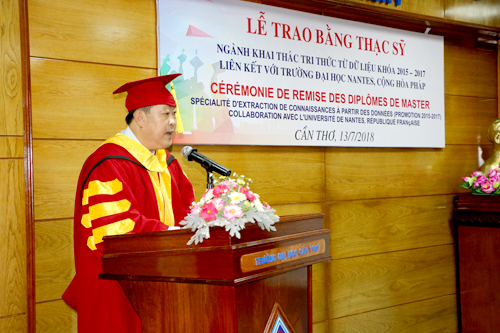
Tên đề tài: “Nghiên cứu sử dụng ozone trong sản xuất giống cua biển (Scylla paramamosain Estampador, 1949)”.
Tác giả: Nguyễn Việt Bắc, Khóa: 2014
Chuyên ngành: Nuôi trồng thủy sản; Mã số: 62620110. Nhóm ngành: Nông-Lâm-Ngư nghiệp.
Người hướng dẫn chính: GS.TS. Vũ Ngọc Út - Trường Đại học Cần Thơ.
- Tóm tắt nội dung luận án
Cua biển (Scylla paramamosain) là đối tượng quan trọng trong nuôi trồng thủy sản. Các giải pháp nhằm cải tiến kỹ thuật, nâng cao tỷ lệ sống cua biển trong quá trình sản xuất giống đang được tập trung nghiên cứu. Đề tài “Nghiên cứu sử dụng ozon trong sản xuất giống cua biển (Scylla paramamosain)” thực hiện nhằm đánh giá ảnh hưởng của ozon lên chất lượng môi trường nước ương, chất lượng trứng và ấu trùng cua biển làm cơ sở cho việc ứng dụng ozon vào sản xuất giống cua biển.
Sáu thí nghiệm được tiến hành trên cua trứng và ấu trùng cua nhằm đánh giá khả năng hòa tan và tồn lưu của ozon trong nước, các chế độ xử lý ozon cho trứng và ấu trùng cua biển (nồng độ, thời gian, tần suất và giai đoạn ấu trùng), cũng như hiệu quả kinh tế của quy trình sản xuất giống cua biển ứng dụng ozon. Ozon được sục trực tiếp vào bể ương với công suất máy 4g/h thông qua hệ thống khí ventuari hoặc đá bọt. Kết quả cho thấy, ở điều kiện trại sản xuất giống (độ mặn 30 ‰, pH = 8,0) thời gian ozon hòa tan và bán rã tùy thuộc vào thể tích nước. Đối với trứng cua biển, xử lý ozon ở nồng độ 0,1 mg/L trong thời gian 60 giây với tần suất 1 ngày/ lần sẽ giúp kiểm soát tốt mật độ vi khuẩn, nấm và ký sinh trong nước ương nhưng không ảnh hưởng đến chất lượng và tỷ lệ nở của trứng với, trứng cua nở đạt 57,4% và 4,25 x 103 ấu trùng/g cua mẹ. Tuy nhiên, ozon ở nồng độ 0,2 – 0,5 mg/L sẽ gây bào mòn vỏ trứng cua.
Trên ấu trùng cua biển, sử dụng nồng độ ozon 0,05 mg/L cho kết quả tốt nhất về chỉ số biến thái và tỷ lệ sống của ấu trùng. Theo đó, ấu trùng cua ở các giai đoạn tiếp xúc với ozon 0,05 mg/L trong vòng 1h không có khác biệt về tỷ lệ sống, nhưng sau 24h thì nồng độ từ 0,1 mg/L gây chết đáng kể so với 0 - 0,05 mg/L. Ở tần suất 1 ngày/lần và nồng độ ozon 0,05 mg/L, mật độ vi khuẩn (khuẩn lạc hay CFU/mL) và vi khuẩn Vibrio tổng (CFU/mL) được kiểm soát ở mức thấp nhất (tương ứng với 2,2 x 103 CFU/mL và 0,2 x 103 CFU/mL), tỷ lệ nhiễm ký sinh thấp nhất (4,86%) và tỷ lệ dị hình 4,96%. Tuy nhiên, chỉ số biến thái qua các giai đoạn (LSI) và tỷ lệ sống của ấu trùng đến cua 1 được ghi nhận cao nhất (10,5%) ở tần suất 2 ngày/lần.
Đánh giá sử dụng ozon trong thực tế sản xuất giống cua biển S. paramamosain được so sánh và đánh giá hiệu quả so với các quy trình đang áp dụng trong sản xuất hiện nay: quy trình sử dụng hóa chất và kháng sinh. Ở mật độ ương 200 con/L, quy trình ozon (0,05 mg/L, với tần suất 2 ngày/lần) cho thấy chất lượng nước (hàm lượng COD, TAN, NO2) mật độ vi khuẩn tổng, Vibrio sp. và tỷ lệ nhiễm ký sinh trùng trên ấu trùng (lần lượt là 0,86 x 104 CFU/mL, 0,16 x 104 CFU/mL và 6,40%) thấp hơn có ý nghĩa thống kê so với các nghiệm thức còn lại. Tương tự, các chỉ số LSI, tăng trưởng của ấu trùng ở nghiệm thức sử dụng ozon cao hơn so với nghiệm thức sử dụng hóa chất. Tỷ lệ sống đến giai đoạn Cua1 (8,81%) và tỷ suất lợi nhuận (1,35) cao nhất ở quy trình sử dụng ozon, sử dụng kháng sinh (7,23% và 0,85), khác biệt có ý nghĩa với nghiệm thức sử dụng hóa chất (2,29% và – 0,4). Bên cạnh đó, chất lượng Cua1 sản xuất bằng quy trình ozon được so sánh tăng trưởng với nguồn cua tự nhiên và nguồn cua được sản xuất nhân tạo ở địa phương (cua sản xuất chủ yếu bằng kháng sinh). Kết quả sau 30 ngày nuôi với thịt tôm, tăng trưởng về khối lượng và tỷ lệ sống của cua giống sản xuất theo quy trình ozon là 0,711 g và 92,8% khác biệt không có ý nghĩa với nguồn cua giống tự nhiên là 0,773 g và 92,8%, nhưng khác biệt có ý nghĩa với nguồn cua sản xuất nhân tạo ở địa phương là 0,414 g và 88%.
Kết quả nghiên cứu cho thấy, xử lý ozon với tần suất 1 ngày/lần với nồng độ 0,1 mg/L trong 60 giây giúp kiểm soát tốt bệnh nấm, khuẩn và kí sinh mà không ảnh hưởng đến chất lượng trứng và ấu trùng cua biển. Xử lý ozon với tần suất 2 ngày/lần ở nồng độ 0,05 mg/L giúp kiểm soát tốt vi khuẩn và ký sinh trùng gây hại cho ấu trùng, cải thiện biến thái, tăng trưởng và tỷ lệ sống của ấu trùng, nâng cao chất lượng Cua1. Kết quả đề tài có thể ứng dụng trong thực tế sản xuất giống cua biển.
Từ khóa: ozon, cua biển, S. paramamosain, sản xuất giống
- Những kết quả mới của luận án
Lần đầu tiên xác định được nồng ozon thích hợp cho giai đoạn trứng và các giai đoạn ấu trùng cua biển. Bên cạnh đó nghiên cứu cũng xác định được tần suất xử lý ozon cho chất lượng trứng, tỷ lệ sống và biến thái của ấu trùng cua biển tốt nhất.
Hoàn chỉnh qui trình sử dụng ozon trong sản xuất giống cua biển
- Các ứng dụng/khả năng ứng dụng trong thực tiễn, các vấn đề cần tiếp tục nghiên cứu
Khả năng ứng dụng trong thực tiễn: Kết quả của luận án cung cấp cho các nhà quản lý (Chi cục Thủy sản, Sở Nông nghiệp và Phát triển nông thôn Tỉnh Cà Mau) và người dân quy trình ương cua giống thân thiện với môi trường, hạn chế sử dụng kháng sinh gây tác hại đến môi trường và sức khỏe người tiêu dùng; góp phần làm đa dạng quy trình ương cua biển; nâng cao hiệu quả ương của giống ở nước ta hiện nay.
Các vấn đề tiếp tục nghiên cứu:
- Cần tiếp tục nghiên cứu giải pháp sục ozon vào môi trường nước để nâng cao hiệu quả hiệu quả hòa tan ozon và giảm công suất máy tạo ra ozon.
- Cần tiếp tục nghiên cứu các tác động của ozon đến giai đoạn cua thịt.
- Cần tiếp tục nghiên cứu sử dụng ozon cho các đối tượng thủy sản khác.
- Research summary
Mud crab (Scylla paramamosain) is an important species for aquaculture. Sustained efforts have reportedly focused on the improvement of practice technologies and enhancement of survival rate in seed production. The present study was carried out to evaluate the effects of ozone disinfection on water quality parameters, egg viability and larval quality in mud crab seed production.
The study consisted of six experiments on ovigerous crab (gravid females) and mud crab larvae. Investigations on effects of dissolved capacity and accumulation of ozone in the rearing water; effects of different ozone concentrations, exposure times, frequencies, on eggs and different larval stages; and the economic efficiency of ozone disinfection application for mud crab seed production. Ozone was directly supplied into rearing tanks at 4 g/h through a venturi pump and air stones. The results showed that in normal hatchery condition settings (i.e. salinity of 30‰ and pH of 8.0), solubility and degrading time of ozone depended on water volume. For mud crab eggs, daily ozone disinfection at 0.1 mg/L for 60s could help control bacterial load, fungi and parasites in rearing water without compromising the quality and hatching index of eggs. In this study, the hatching index was recorded at 57.4% with a fecundity of 4.25 x 103 larvae/g of crab female. However, we observed that at higher ozone disinfection rates (0.2-0.5 mg/L) could cause damage to the shell surface of eggs.
For mud crab larvae, ozone concentration at 0.05 mg/L showed the best results in larval metamorphosis (Larval stage index or LSI) and survival. No significant difference in survival of crab larvae was observed when exposed to 0.05 mg/L for 1 hour. However, the larval mortality significantly increased after 24h exposure to ozone at 0.1 mg/L as compared to 0 – 0.05 mg/L. At daily exposure frequency and 0.05 mg/L ozone concentration, the total bacteria density (colony-forming unit or CFU/mL) and Vibrio density (CFU/mL) were managed at low levels (2.2 x 103 CFU/mL and 0.2 x 103 CFU/mL), low parasitic infection (4.86%), and deformation index (4.96%). However, the larval stage index and survival rate of mud crab larvae until Crab 1 stage (10.5%) was highest at 2 days/time of exposure frequency.
A comparison among common practice protocols in mud crab larvae was carried out including ozone application, chemicals application and antibiotics application. At a stocking density of 200 larvae/L, the ozone application protocol (0.05 mg/L and exposed every 2 day) demonstrated that water quality parameters (COD, TAN and Nitrite), total bacteria count, Vibrio count and parasitic infection on the larvae (0.86 x 104 CFU/mL, 0.16 x 104 CFU/mL and 6.40%) were statistically lower than those in other protocols. Similarly, the LSI and growth performance of crab larvae in ozone treatment were significantly greater than the chemical application protocol. Highest values of larval survival rate at crab 1 stage (8.81 %) and net profit (1.35) were recorded in ozone application protocol, followed by antibiotic application protocol (7.23 % and 0.85) which were significantly higher than those in chemical application protocol (2.29 % and – 0.4). In addition, quality of crab seed produced by ozone application protocol was also compared to wild seed and local hatchery crab seed (using antibiotic). After 30 days of rearing (fed with shrimp meat), growth in weight and survival of crabs produced from ozone application protocol were at 0.711 g and 92.8%, and not significantly different to those of wild crab seed (0.773 g and 92.8%), but statistically higher than those of local hatchery crab seed (0.414 g and 88%).
The results from this study demonstrated that daily ozone disinfection at a concentration of 0.1 mg/L for 60 seconds could help control fungi, bacteria, and parasites without compromising egg and larval quality. At 0.05 mg/L and exposed every 2 days, management of pathogenic bacterial load and parasites can be achieved with improvements in metamorphosis, growth performance, survival and quality of mud crab. Findings from this study could aid in applications of mud crab seed production and improved husbandry practices.
Keywords: Ozone, mud crab, Scylla paramamosain, seed production
- Research Creativeness
This is the first ever study determining the appropriate ozone concentrations used for disinfection of incubated eggs and larval stages of mud crabs. Besides, this study also determined the ozone application frequency for the best quality of egg, metamorphosis, and survival of mud crab larvae.
- The applications/potential applications in mud crab farming, and the perspectives of this study
The potential applications in mud crab farming:
The results of the thesis provide the managers (Fisheries Department, Department of Agriculture and Rural Development of Ca Mau province) and people a foundation to apply ozone in mud crab production systems. This study also develops new and environmentally friendly protocols for mud crab hatchery, reducing use of antibiotics and chemicals that giving negative effects on the environment and human health. Besides, the study also contributes to diversify mud crab rearing technologies as well as improve the efficiency of mud crab hatchery.
Issues of further research:
Further studies are required to develop effective methods for ozonation to improve the ozone solubility and reduce the capacity of ozone creators.
Further studies are required to continue to study the effects of ozone application on mud crab at grow-out phase.
Further studies are to evaluate the ozone applications for other aquatic species.
- Xem chi tiết nội dung luận án
- Xem thông tin đăng tải tại Website Bộ giáo dục và Đào tạo. (Nhập tên NCS vào ô tìm kiếm)




















